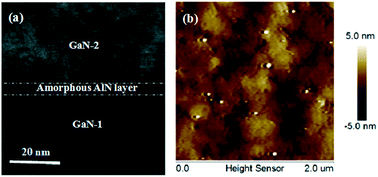Design and epitaxial growth of quality-enhanced crack-free GaN films on AlN/Al heterostructures and their nucleation mechanism
Abstract
The epitaxial structures of GaN films grown on AlN/Al heterostructures by pulsed laser deposition (PLD) are designed with and without an amorphous AlN layer, and quality-enhanced crack-free GaN epitaxial films are obtained. Compared with GaN epitaxial films grown without inserting the amorphous AlN layer, by inserting a ∼5 nm-thick amorphous AlN layer in GaN, the residual stress in ∼600 nm-thick GaN epitaxial films is greatly reduced from −0.81 to −0.19 GPa, and high-density dislocations are annihilated in the amorphous AlN layer. The full-width at half-maximum for GaN(0002) and GaN(10-12) decreases from 1.1° and 1.2° to 0.90° and 0.98°, respectively. The root-mean-square surface roughness of as-grown GaN epitaxial films is also decreased from 3.5 to 1.5 nm. Evidently, the amorphous AlN layer can release the stress and trap the dislocations, preventing them from extending into the upper layer, as well as improve the surface morphology of GaN epitaxial films. Moreover, the nucleation mechanism of dislocation formation and annihilation in GaN epitaxial films grown on AlN/Al heterostructures by PLD with an amorphous AlN layer is hence proposed. These quality-enhanced GaN epitaxial films are of paramount importance for the application of GaN-based optoelectronic devices.



 Please wait while we load your content...
Please wait while we load your content...